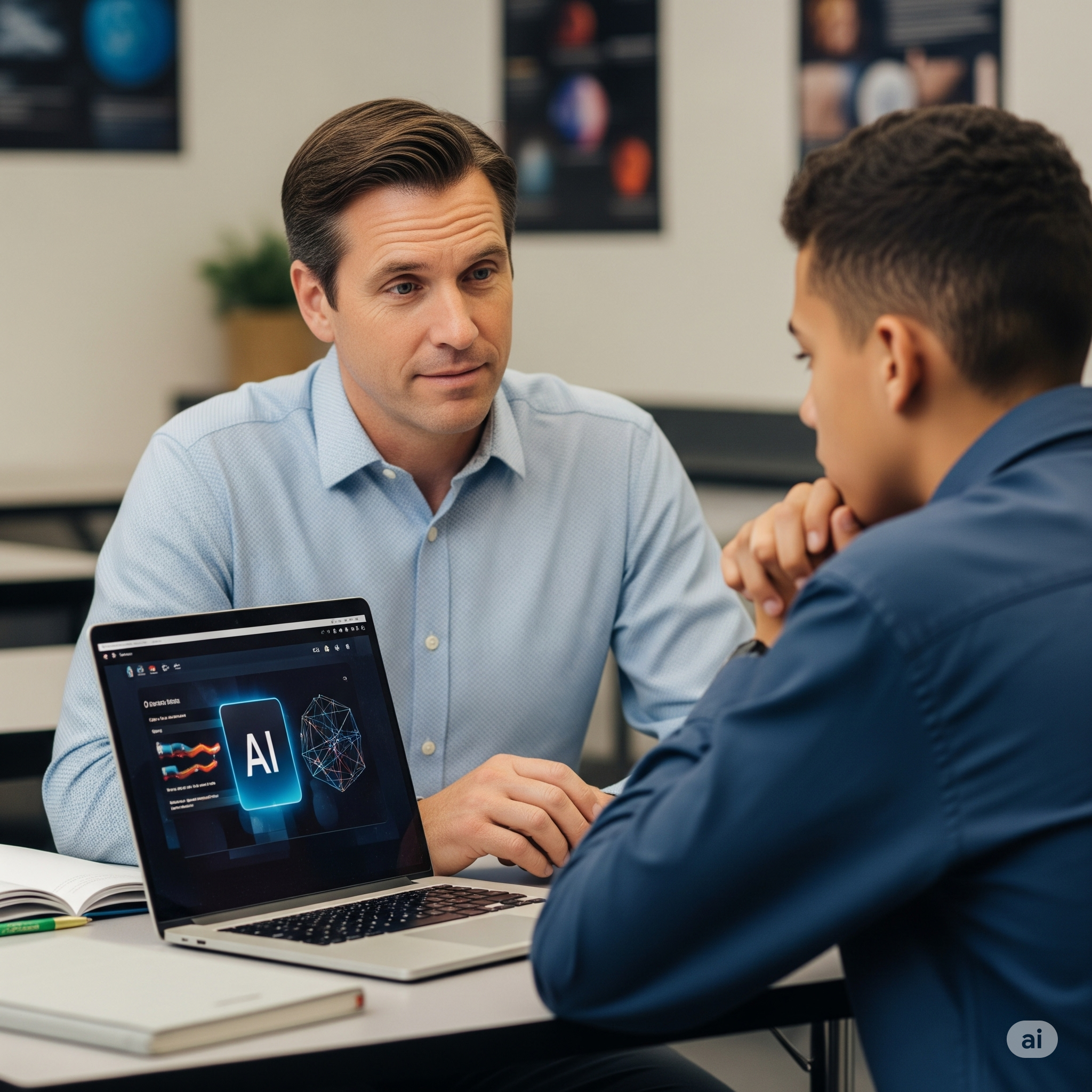AI and Academic Integrity: A Restorative Path to Honesty
In our increasingly digital world, new challenges emerge in the realm of education. One such challenge, appearing more frequently, involves students utilizing Artificial Intelligence to complete academic work without genuine effort or proper attribution. This isn't just about plagiarism; it strikes at the core of academic honesty and the very purpose of learning. This article will explore how restorative practices can effectively address such issues, getting to the heart of ethical engagement with AI and fostering true academic integrity.
Unpacking the Scenario: Identifying the Breach
Consider this scenario: Mr. Harrison, a science teacher, suspects one of his students, Leo, has used an AI tool to generate an entire presentation for his biology class. The slides are visually polished and contain complex information, yet they lack the nuanced understanding and personal voice Mr. Harrison has come to expect from Leo. Crucially, there are no references or citations for the extensive data presented. After running the content through AI detection tools and reviewing Leo's previous work, it becomes clear that the entire presentation was created by AI without any accompanying research or original writing by the student.
Here's how a restorative approach can navigate this academic honesty issue. First, Mr. Harrison approaches Leo privately and calmly. Instead of launching into accusations, the conversation begins with observations and concerns. "Leo, I've noticed some elements in your biology presentation that are quite different from your usual writing. For instance, the scientific terms are very sophisticated, but the structure doesn't quite align with how we've discussed organizing data. Can you tell me about your process for creating these slides and gathering your research?" This open-ended question invites Leo to explain without immediately feeling defensive, creating a foundation for dialogue rooted in curiosity, not condemnation. This initial approach is crucial for establishing a space where a student feels safe enough to be honest, a core principle of restorative dialogue.
Addressing the Harm: Beyond Just the Grade
Once it's confirmed that AI was used without proper engagement or attribution, the conversation shifts to exploring the harm caused. This harm is multi-faceted and extends far beyond just a lowered grade; it impacts individuals and the collective learning environment.
Harm to Leo himself: By relying on AI to bypass the learning process, Leo missed a crucial opportunity for genuine intellectual development. He didn't engage in the critical thinking, in-depth research, analytical reasoning, and synthesis of information that are the true goals of the assignment. This shortcut ultimately hinders his academic growth, development of essential skills for future studies, and his confidence in his own abilities. He robbed himself of the satisfaction of true accomplishment.
Harm to the teacher (Mr. Harrison): Trust has been broken. Mr. Harrison invests time and effort into guiding Leo's learning, and when work is not authentic, it becomes impossible to accurately assess what Leo has truly understood, what concepts he's struggling with, or where he might need targeted support. This undermines the teaching relationship and makes effective instruction more challenging. It's akin to a doctor receiving inaccurate patient information; the ability to provide proper care is severely compromised.
Harm to classmates: This creates an unfair academic advantage for Leo, potentially devaluing the honest effort and hard work other students have poured into their own original presentations. Classmates who spent hours researching, drafting, and refining their work might feel discouraged or unfairly treated when others achieve similar results through illegitimate means. This can foster resentment and erode the collective motivation for diligent, honest work within the classroom.
Harm to the learning community: The integrity of the academic environment is fundamentally compromised. When academic standards are not upheld, and the authenticity of student work is questionable, the entire educational ecosystem suffers. The value of degrees, grades, and the learning process itself diminishes for everyone, making it harder to foster a culture of genuine scholarship and intellectual curiosity.
A powerful and empathetic question to pose to Leo, once he understands the basic facts of the situation, would be, "When you decided to use AI to create this presentation without doing your own research or writing, what impact do you think that has on my ability to trust your work, on your own learning and growth as a student, and on the fairness of our classroom for your peers?" This question encourages holistic reflection on the consequences of his actions.
This incident presents a crucial "teachable moment"—an opportunity to transform a misstep into profound learning. Many students, navigating the rapidly evolving landscape of AI tools, may not fully grasp the ethical implications or the appropriate boundaries for using AI in academic work. This is an opportune moment to educate Leo on proper citation, the principles of honest research, and how AI is intended to be a tool for learning, not a replacement for his own critical thinking and effort. Provide clear, concrete examples of when AI can be used appropriately (e.g., for brainstorming initial ideas, structuring an outline, clarifying complex concepts, identifying grammatical errors, or even generating rough drafts that are then heavily edited and cited as inspiration) versus when its use constitutes academic dishonesty. Emphasize the profound value of his own unique voice, original thought, and the critical thinking skills he is meant to develop—skills that AI, by its very nature, cannot replicate. Research from institutions like Kwantlen Polytechnic University (2020) explicitly outlines how integrating ethical AI use into academic integrity instruction can significantly encourage personal growth and build essential academic skills, leading to more sustainable behavioral changes than punitive measures alone. This educational component is vital for equipping students to navigate the complexities of modern information tools responsibly.
Crafting a Plan for Repair and Prevention: Rebuilding Integrity and Skills
The next critical step involves working collaboratively with Leo to develop a constructive plan to make things right and to prevent similar incidents from recurring. This plan should be mutually agreed upon, meaningful, and directly address the identified harms. It moves beyond punishment to focus on rehabilitation and skill-building. Possible restorative actions, tailored to Leo's specific needs and the severity of the situation, could include:
Re-create the presentation with genuine effort: Leo must redo it, showing authentic engagement, thorough research, and his own understanding. To ensure originality, he may choose a new related topic or a different format like a debate or scientific inquiry.
Attend Academic Integrity Workshop/Module: Leo must complete a school workshop or online module on academic integrity, ethical AI use, research methods, and citation practices, featuring interactive case studies for deeper learning.
Rebuilding Trust: Leo could hold regular, brief check-ins with Mr. Harrison to discuss his research and writing, share outlines, notes, and drafts. This transparency builds accountability and ensures proper academic guidance.
Peer Education: Leo might research and present to classmates on ethical AI use in academics, turning his mistake into a positive lesson and showing genuine remorse and commitment to change.
Engaging Parents: A Partnership in Learning and Growth
Finally, it is essential to communicate effectively and transparently with Leo's parents about what happened and the comprehensive restorative plan developed. Frame this conversation as a learning opportunity for Leo rather than solely a disciplinary action. Explain the incident clearly, outlining the specific harms identified (to Leo's learning, the teacher's trust, class fairness, and academic integrity) and the specific, constructive steps Leo will take to make amends and learn from this experience. Discuss how they, as parents, can actively support Leo at home in adhering to the repair plan, perhaps by monitoring his study habits, engaging in conversations about the ethical use of technology, or helping him manage his time effectively to avoid shortcuts.
In this context, having Leo lead parts of the conversation with his parents can be remarkably effective and empowering. For example, "Mom and Dad, I want to tell you about a mistake I made with my biology presentation and what Mr. Harrison and I have decided I need to do to fix it and truly learn from it." This act of self-advocacy enables Leo to take greater ownership of his actions, demonstrates his growing responsibility, and fosters crucial transparency within the family unit. This collaborative approach with families is consistently cited as a key factor in the long-term success and sustainability of restorative practices, building a strong, unified support network around the student that extends beyond the school walls (Riestenberg, 2006). When parents are partners in the restorative process, the lessons learned are often deeper and more enduring.
Conclusion: Fostering Integrity in a Digital Age
Dealing with AI misuse and plagiarism through a restorative lens is not about overlooking academic dishonesty; it's about holding students accountable in a way that truly builds integrity, cultivates essential critical thinking, and instills a deep respect for the learning process. It transforms a disciplinary problem into a powerful, real-world lesson in ethics, personal responsibility, and effective digital citizenship. By guiding students through this comprehensive restorative process—from understanding harm and taking accountability to actively repairing the damage and developing new skills—we equip them with the tools and mindset necessary to navigate the ever-changing academic world with honesty, resilience, and a genuine commitment to their own intellectual development. This proactive approach benefits not just the individual student, but strengthens the academic fabric of the entire school community.
Citations:
Gonzalez, T. (2012). Restorative Justice in Schools: A Research Review. National Center for Youth Law.
Hopkins, B. (2004). Just Schools: A Whole School Approach to Restorative Justice. Jessica Kingsley Publishers.
Kwantlen Polytechnic University. (2020). Academic Integrity: A Guide for Students. Retrieved from https://www.kpu.ca/library/services/academic-integrity/students
(Note: While the specific "research" mentioned in the podcast script might not be a single published paper, many universities, like KPU, provide educational resources that advocate for teaching and restorative approaches in academic integrity. This citation points to one such resource that aligns with the blog's educational theme.)
Morrison, B., & Vaandering, D. (2012). From restorative justice to restorative practice: The evolution of a concept. In H. Strang & J. Braithwaite (Eds.), Restorative justice and civil society (pp. 31-48). Cambridge University Press.
Riestenberg, J. (2006). The Use of Restorative Practices to Reduce Disproportionality in Schools. Paper presented at the National Summit on Protecting Children and Advancing their Human Rights, Washington, D.C.


